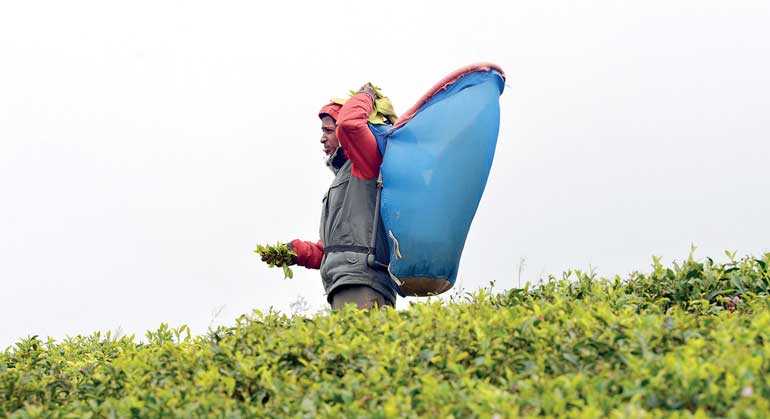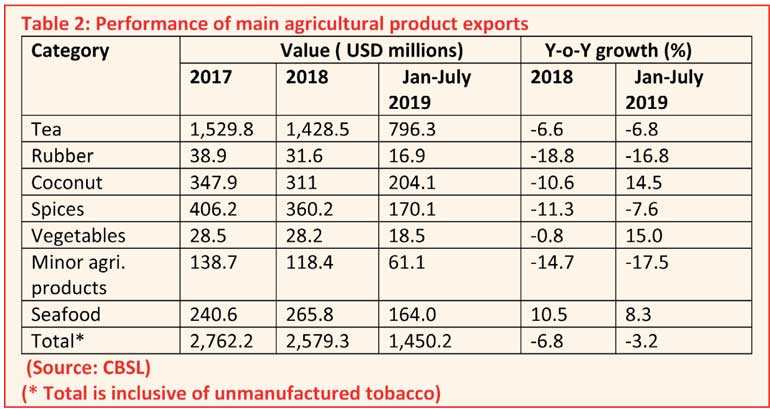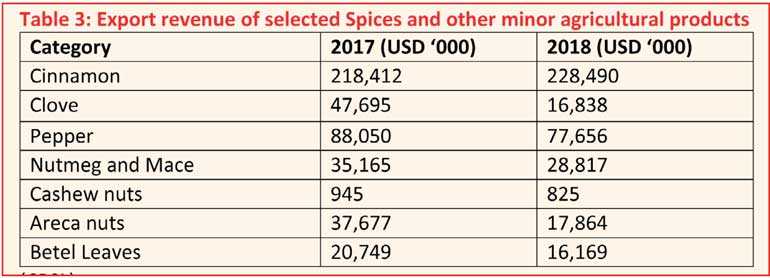Thursday Apr 24, 2025
Thursday Apr 24, 2025
Thursday, 17 October 2019 01:57 - - {{hitsCtrl.values.hits}}



During the past two years, there is a marked increase in the export revenue as indicated in table 1. The export earnings from January to July 2019 also grew by 2.8% compared to the corresponding period of the previous year, despite the uncertainties caused by Easter Sunday attacks in April. However, there is no room for complacency as the country’s export revenue remains low as a percentage of GDP and also considering macroeconomic challenges such as decrease of remittances by migrant workers, external debt repayment, etc. 
Decline in the main agricultural product categories
Despite the increase in total export revenue, there is significant decline in agricultural product exports during the recent past.
According to table 2, in 2018 and subsequently, during the period of January to July 2019, the total earnings from agricultural product exports has decreased by 6.8% and 3.2% respectively. Only the seafood sector has been able to record continuous growth. The seafood sector which has reaped the benefit of GSP+ concession is set to face challenges in the near future due to the fact that Sri Lanka has achieved the upper middle income status which will lead to the disqualification for GSP.
According to table 2, the product sectors such as minor agricultural products, rubber and spices have experienced a drastic decline in 2018 and Jan-July 2019 than other product categories. The export earnings from tea also declined, whereas coconut and vegetable sectors have shown some improvement during the period of Jan-July 2019. The decrease of export revenue from tea can be attributed to the trade sanctions imposed on Iran and Russia that restrict the exports, and disruptions to the tea production due to trade union actions, etc.
Decline in the spices and minor agricultural products
According to table 3, it is evident except for cinnamon the export revenue from all other products has been decreased. Detailed analysis would reveal the combined impact of decrease in the prices and volumes has led to the decline in export revenue. The reduction of revenue from spices is noteworthy, because the spice sector has been included in the National Export Strategy (2018-22) as one of the six priority sectors. During a recent field visit, the writer observed, stocks of harvested spices remain unsold due to low prices.

Agricultural product exporters face various non-tariff barriers more than other product exporters that impede the export growth. For example, exporters recently pointed out about the imposition of minimum import price by an importing country for areca nuts that hinder the exports from Sri Lanka. Because if the minimum import price is higher than the local market prices of importing country, exporters will lose the market.
Poor become poorer
The contribution from agriculture to GDP is around 7% whereas the agri-sector provides around 25% out of the total employment in Sri Lanka. Accordingly, it is evident that a significant portion of the workforce, those who are employed in the agriculture sector get only a marginal income. Therefore, the decrease in the export revenue of agricultural products means, those who are engaged in the agri-sector will have to struggle more to fulfil their basic necessities.
One can argue, the decrease of revenue from agricultural product exports is a common phenomenon when a country progresses through the various stages of development. The dual sector theory introduced by Arthur Lewis in the 1950s explains that the surplus labour in traditional sectors which include agriculture, will shift to the industrial sector with the gradual improvement of industries. However, the question is whether we have a flourishing industrial sector to propel the economic growth of the country.
(The writer, an economic policy researcher, can be contacted [email protected].)
Discover Kapruka, the leading online shopping platform in Sri Lanka, where you can conveniently send Gifts and Flowers to your loved ones for any event including Valentine ’s Day. Explore a wide range of popular Shopping Categories on Kapruka, including Toys, Groceries, Electronics, Birthday Cakes, Fruits, Chocolates, Flower Bouquets, Clothing, Watches, Lingerie, Gift Sets and Jewellery. Also if you’re interested in selling with Kapruka, Partner Central by Kapruka is the best solution to start with. Moreover, through Kapruka Global Shop, you can also enjoy the convenience of purchasing products from renowned platforms like Amazon and eBay and have them delivered to Sri Lanka.
Discover Kapruka, the leading online shopping platform in Sri Lanka, where you can conveniently send Gifts and Flowers to your loved ones for any event including Valentine ’s Day. Explore a wide range of popular Shopping Categories on Kapruka, including Toys, Groceries, Electronics, Birthday Cakes, Fruits, Chocolates, Flower Bouquets, Clothing, Watches, Lingerie, Gift Sets and Jewellery. Also if you’re interested in selling with Kapruka, Partner Central by Kapruka is the best solution to start with. Moreover, through Kapruka Global Shop, you can also enjoy the convenience of purchasing products from renowned platforms like Amazon and eBay and have them delivered to Sri Lanka.